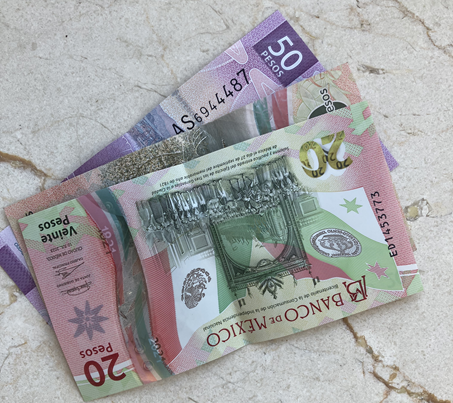Tipping in Mexico can be a thorny issue. Locals and foreigners often follow very different practices. Below, I’ll explore the much-debated topic of how much to tip in Mexico, and for what kinds of purchases.
If you’ve recently arrived from up north, you’re likely familiar with discussions about a tipping culture gone mad in the U.S., with tip sizes (and asks) surging since the pandemic.
Here in Mexico, some argue that American culture is imposing itself too much, courtesy of globe-trotting gringos. So whether you’re new to living life abroad or a long-time resident, it’s worth reflecting on – and understanding local practices.
How Much do Mexicans Tip, and For What?
Below are some examples from Mexican families and individuals, gathered from my own network as well as social media threads on the topic.
“The only time my wife, mother-in-law, or Mexican family ever tips consistently is in restaurants, [plus] 1-5 pesos for those guys in parking lots or who clean your windows at red lights, and grocery baggers. That’s it.”
“I only tip for: viene vienes: 3-5 pesos, cleaning [car] windows [at a stop light]: 3-5 pesos, grocery baggers: 3-5 pesos, meals at sit-down restaurants: 10%, drinks at café: 10%.”
“Never less than 10% for waiters in a restaurant, with 15% for really good service. In grocery stores, I normally tip baggers 10 pesos, but if my mom and I buy a lot of stuff and they help us to the car, I’d give up to 50 pesos.”
I also routinely see Mexicans tipping the garbage collector when they have extra items to haul away, e.g., after a party or when they have large boxes lying around from some large new purchase.
There are notable differences in tipping by generation. One Mexican friend (a Millennial) shared that her elderly relatives tip a lot less than she does, e.g., leaving 20 or 30 pesos on a restaurant tab, no matter how much they spent, while making it very clear she didn’t approve.
As with many things, wealthy Mexicans sometimes upend standard conventions. As one local told me, the wealthy sometimes tip generously as a way to signal their status among friends or colleagues, not as a gesture to reward service staff. Ooof.
For the newcomers, tips may be referred to in Spanish as a “propina” or “el servicio,” depending on the situation.
Where Are Tips Uncommon/Not Expected in Mexico?
Here is a partial list of services where tips are not expected or necessary in Mexico.
Consistent with the U.S., you would never tip for professional services like doctors, dentists, lawyers, notaries, architects, or physical therapists.
It’s also uncommon to tip hairdressers, taxi drivers, street food vendors, and house cleaners, though I know plenty of gringos who do it, as you can see below.
How Much are Gringos Tipping in Mexico?
There is no single example I could give that’s representative of this diverse group.
But a post I found on Reddit by an American living in a major Mexican city (displayed in full below, with my notes to clarify the task) aligns pretty closely with what I’ve observed gringos doing here in Guadalajara.
- Restaurants: 10%-20%, but mostly 15%
- Restaurant delivery: $20-30 pesos
- Grocery Baggers: $5-10 pesos per visit
- Garrafon (purified water) delivery: $5-15, depending on how many bottles
- Gas station attendants: $10 if they wash the windows
- Car Wash: $50 pesos when I get the wash and interior cleaned
- Grocery delivery: $20-50 pesos, depending on the size of the order
- Furniture delivery: $50 per guy and a bottle of water or soda
- Haircut: 25%
- Gas (propane) delivery: Bottle of water or soda
- Taxi Driver: Nothing unless they do something extra (help with luggage, etc.)
- Uber drivers: $20 pesos if their cars are clean and they have the a/c on
- Viene vienes (the guys that wave you to a parking space on the street): $5-10 pesos
Obviously, many of these deviate from standard practice among Mexicans, in size and place of service.
While tips aren’t required or expected in many of the situations listed above, here are a few more places in Mexico where tipping is customary and expected.
Hotels. Be sure to tip anyone who helps you with luggage, hails you a taxi, arranges a restaurant reservation, or cleans your room. Figure $20-50 pesos for each activity (depending on the level of difficulty), with maids being tipped daily.
Guided tourist activities such as tours or other excursions. Since these things range widely in cost, I’d recommend tipping your guide at least 10% of its value, and more if the service was exceptional.
Parking valets at a restaurant or a fancy shop. At least 20 pesos.
Street buskers and musicians in restaurants. As a lifelong music lover, I always try to tip talented locals who are invariably scraping by and pursuing their passion. At least 20 pesos.
Spas. When receiving personal care services such as massage, facials, or nail care, it’s customary to tip the therapist, etc., 10%+.

What Do Mexican Service Workers Expect in Tips?
In my experience, expectations vary widely depending on who the customer base is. When a business is heavily patronized by gringos, the staff’s expectations are likely to be significantly higher than what’s true across Mexico generally.
In touristy areas, e.g., Roma Norte in Mexico City or a famous resort area, staff expectations are remarkably similar to those in the U.S. Anything less than 15% may elicit a negative response. On occasion, it gets taken to extremes. A business may apply a tip to your bill automatically (hello, Puerto Vallarta!) in violation of Article 10 of Mexico’s Federal Consumer Law.
On the other hand, at businesses where Mexicans are 99% of the customers, a tip of 10% is always warmly received.
My philosophy on tipping is similar to my general advice on living as an expat. That is … Try to adopt the practices of locals unless they’re exploitative or cruel.
And remember, even though tipping is optional, there’s no excuse for stiffing service workers just because you can — or leaving them only a few coins. (even if you’re European and never leave tips in your home country)

What Mexicans Think About Over-Tipping
When I’ve asked Mexicans point-blank… What amount do you consider to be overtipping? I typically hear “20%.”
One Mexican resident put it this way…
“Tipping 20% in Mexico is a form of imposing U.S. culture on Mexico. Locals really can’t tip that much, and doing so creates resentment toward the people who do because they’re essentially buying preferential treatment that is out of reach to everyday Mexicans.”
When foreigners dismiss Mexican customs in favor of customs practiced in their home countries (either intentionally or out of ignorance), it comes across to many locals as self-righteous or arrogant.
The decision is up to you, but I found these comments thought-provoking.
How Should You Tip in Mexico?
Pesos vs. Dollars
This is an easy one. Always, always tip in pesos.
If you tip in U.S. (or Canadian) dollars, the recipient must visit a local money changer to get pesos. In the transaction, they can lose 5%-10% of the funds to commission and fees, because changing physical cash (bills only) is always costly in Mexico.
While it may have been true decades ago, businesses in Mexico do not accept payments in a foreign currency without applying a hefty markup.

Cash vs. Credit
Tip in cash whenever you can. Front-line service staff may never see those tips you make via credit card due to unscrupulous owners/managers.
Skimming of tips can happen at high-end places, low-end spots, and everything in between. So, if you want to make certain that your waiter or masseuse receives 100% of your tip, give it to them in cash.
Conclusion
In a society where front-line service staff are poorly paid, it’s understandable that some gringos want to be very generous with tips, thinking that they’re helping to address an economic injustice. But our actions do have consequences for locals, sometimes unintended and counterproductive, even if we don’t want to admit it.
And while I don’t see this debate over how much you should tip getting settled anytime soon, I’ll reiterate that being a good immigrant means being respectful of local customs and practices. Always try to be informed, and use your best judgment out there.

